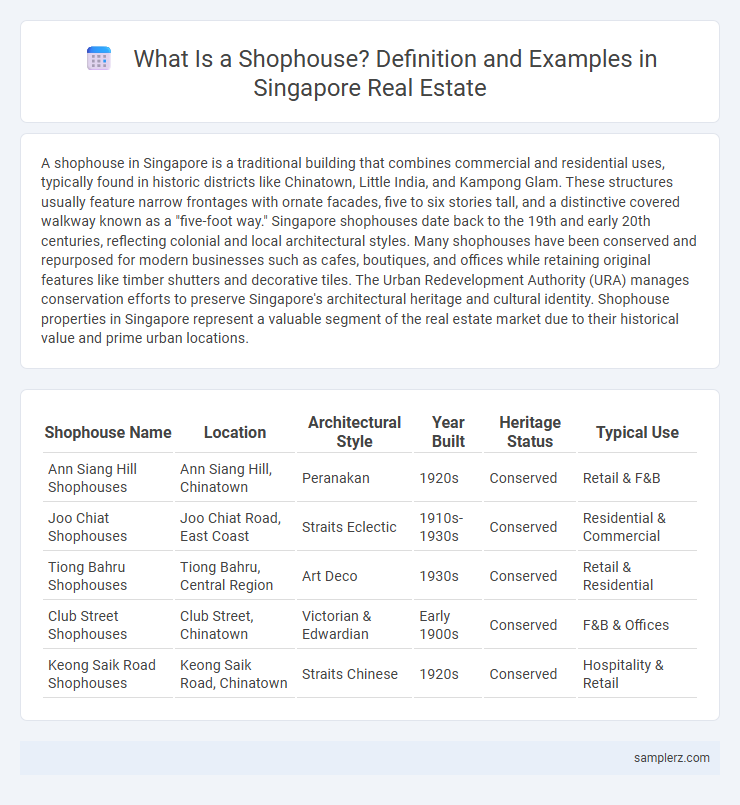A shophouse in Singapore is a traditional building that combines commercial and residential uses, typically found in historic districts like Chinatown, Little India, and Kampong Glam. These structures usually feature narrow frontages with ornate facades, five to six stories tall, and a distinctive covered walkway known as a "five-foot way." Singapore shophouses date back to the 19th and early 20th centuries, reflecting colonial and local architectural styles. Many shophouses have been conserved and repurposed for modern businesses such as cafes, boutiques, and offices while retaining original features like timber shutters and decorative tiles. The Urban Redevelopment Authority (URA) manages conservation efforts to preserve Singapore's architectural heritage and cultural identity. Shophouse properties in Singapore represent a valuable segment of the real estate market due to their historical value and prime urban locations.
Table of Comparison
| Shophouse Name | Location | Architectural Style | Year Built | Heritage Status | Typical Use |
|---|---|---|---|---|---|
| Ann Siang Hill Shophouses | Ann Siang Hill, Chinatown | Peranakan | 1920s | Conserved | Retail & F&B |
| Joo Chiat Shophouses | Joo Chiat Road, East Coast | Straits Eclectic | 1910s-1930s | Conserved | Residential & Commercial |
| Tiong Bahru Shophouses | Tiong Bahru, Central Region | Art Deco | 1930s | Conserved | Retail & Residential |
| Club Street Shophouses | Club Street, Chinatown | Victorian & Edwardian | Early 1900s | Conserved | F&B & Offices |
| Keong Saik Road Shophouses | Keong Saik Road, Chinatown | Straits Chinese | 1920s | Conserved | Hospitality & Retail |
Iconic Shophouse Districts in Singapore
Singapore's Tanjong Pagar and Chinatown districts showcase iconic shophouse architecture featuring conserved rows of two- to three-story buildings with ornate facades, pastel colors, and intricate wooden shutters. These historic shophouses blend commercial and residential uses, offering vibrant street-level retail and boutique spaces above. Preservation efforts have transformed these districts into cultural landmarks, attracting both tourism and investment in heritage real estate.
Architectural Styles of Singapore Shophouses
Singapore shophouses showcase distinctive architectural styles such as the ornate Baroque, the colorful Peranakan with intricate tilework, and the streamlined Art Deco characterized by geometric shapes. These styles reflect the multicultural heritage and colonial influences prevalent during the late 19th and early 20th centuries. Preservation efforts have maintained these iconic facades in areas like Chinatown and Joo Chiat, highlighting their cultural and historical significance.
Heritage Shophouses: Conservation and Preservation
Heritage shophouses in Singapore, such as those in Chinatown and Katong, exemplify the city's commitment to conservation and preservation through adaptive reuse and stringent conservation guidelines. These iconic two- to three-story structures, characterized by their traditional architecture and ornate facades, have been transformed into vibrant commercial and cultural spaces while maintaining their historical integrity. The Urban Redevelopment Authority's conservation efforts ensure these shophouses remain protected landmarks, blending cultural heritage with modern urban development.
Modern Adaptations: Shophouses as Trendy Cafés
Modern adaptations of shophouses in Singapore have transformed traditional spaces into trendy cafes that blend heritage architecture with contemporary design. These establishments often feature minimalist interiors, open layouts, and seamless indoor-outdoor spaces, attracting both locals and tourists seeking unique dining experiences. The fusion of preserved colonial-era facades with modern amenities highlights Singapore's commitment to cultural preservation alongside urban innovation.
Shophouses Turned Boutique Hotels
Shophouses in Singapore, particularly in districts like Chinatown and Kampong Glam, have been ingeniously transformed into boutique hotels, blending heritage architecture with modern luxury. These boutique hotels preserve intricate Peranakan tilework and timber facades while offering personalized services and contemporary amenities. This adaptive reuse not only enhances cultural tourism but also boosts the local economy by attracting travelers seeking unique, authentic stay experiences.
Investment Potential of Singapore Shophouses
Singapore shophouses, particularly those in heritage districts like Chinatown and Tiong Bahru, offer strong investment potential due to their rarity and historical significance. These properties command premium rental yields, benefiting from both commercial and residential demand in prime urban locations. The constant urban redevelopment plans by the Singapore government further enhance the capital appreciation prospects of shophouses.
Famous Shophouse Landmarks in Singapore
The iconic Tan Teng Niah Shophouse in Little India showcases vibrant colors and intricate Chinese architectural details, making it a standout landmark in Singapore's heritage scene. Another notable example is the Tiong Bahru shophouses, which blend Art Deco influences with modern renovations, highlighting the district's historical charm. These preserved structures exemplify Singapore's commitment to maintaining its cultural identity amidst urban development.
Shophouse Prices and Market Trends
Shophouse prices in Singapore have experienced a steady increase, with prime locations like Chinatown and Tiong Bahru commanding prices upwards of SGD 2 million for well-preserved heritage units. Market trends indicate growing demand driven by their unique blend of commercial and residential use, appealing to investors and entrepreneurs seeking iconic properties. Limited supply and conservation efforts continue to support strong capital appreciation in this niche segment of the real estate market.
Success Stories: Businesses Thriving in Shophouses
Businesses in Singapore's shophouses like those on Ann Siang Hill and Kampong Glam have experienced remarkable growth by leveraging the heritage charm and strategic locations. Successful ventures such as boutique cafes, artisanal retail shops, and creative agencies attract both locals and tourists, enhancing foot traffic and community engagement. This blend of tradition and modernity in shophouse spaces creates a dynamic environment fostering long-term commercial success.
Legal Considerations When Buying Shophouses
Purchasing shophouses in Singapore requires careful attention to legal considerations such as the Urban Redevelopment Authority (URA) zoning regulations and the Building Maintenance and Strata Management Act, which govern usage and maintenance responsibilities. Buyers must verify the shophouse's land tenure, whether freehold or 99-year leasehold, as this impacts long-term property ownership and value. Ensuring compliance with conservation guidelines for heritage-listed shophouses is essential to avoid penalties and preserve architectural integrity.

example of shophouse in Singapore Infographic
 samplerz.com
samplerz.com